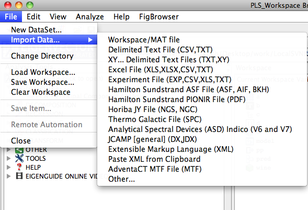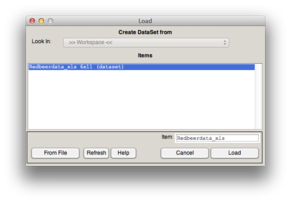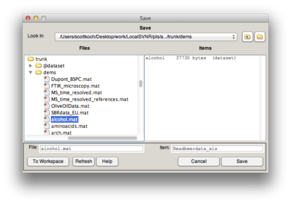Workspace Browser: Importing Data: Difference between revisions
imported>Jeremy No edit summary |
imported>Jeremy No edit summary |
||
| Line 8: | Line 8: | ||
{| | {| | ||
|- | |- valign="top" | ||
| | | | ||
| Line 17: | Line 17: | ||
{| | {| | ||
|- | |- valign="top" | ||
| | | | ||
| Line 34: | Line 34: | ||
{| | {| | ||
|- | |- valign="top" | ||
| | | | ||
| Line 43: | Line 43: | ||
{| | {| | ||
|- | |- valign="top" | ||
| | | | ||
| Line 52: | Line 52: | ||
{| style="margin-left:18pt" | {| style="margin-left:18pt" | ||
|- | |- valign="top" | ||
| | | | ||
| Line 61: | Line 61: | ||
{| style="margin-left:18pt" | {| style="margin-left:18pt" | ||
|- | |- valign="top" | ||
| | | | ||
| Line 74: | Line 74: | ||
{| | {| | ||
|- | |- valign="top" | ||
|1. | |1. | ||
| Line 84: | Line 84: | ||
:A list of available file types that you can import opens. The first option in the list is the Workspace/MAT file option. | :A list of available file types that you can import opens. The first option in the list is the Workspace/MAT file option. | ||
:''List of available file types'' | |||
::[[Image:SOLO_workspace_browser_Importing_Data.png|308x257px]] | ::[[Image:SOLO_workspace_browser_Importing_Data.png|308x257px]] | ||
| Line 91: | Line 91: | ||
{| | {| | ||
|- | |- valign="top" | ||
|2. | |2. | ||
| Line 101: | Line 101: | ||
:The Load dialog box opens. By default, this dialog box references the currently opened workspace, and therefore, lists all of the items that are currently loaded in the workspace. | :The Load dialog box opens. By default, this dialog box references the currently opened workspace, and therefore, lists all of the items that are currently loaded in the workspace. | ||
:''Load dialog box'' | |||
::[[Image:Load_dialog_box.png|291x206px]] | ::[[Image:Load_dialog_box.png|291x206px]] | ||
| Line 108: | Line 108: | ||
{| | {| | ||
|- | |- valign="top" | ||
|3. | |3. | ||
| Line 120: | Line 120: | ||
:Note: In MATLAB, an item is called a variable, and it is the type of data that can be stored in a .mat file. An item can be a DataSet, a matrix, a character array, and so on. Although this documentation uses the term "item," the term "variable" is used on various windows and dialog boxes and in some lists in Solo. Multiple variables, DataSet objects, and so on can be stored in a single .mat file. | :Note: In MATLAB, an item is called a variable, and it is the type of data that can be stored in a .mat file. An item can be a DataSet, a matrix, a character array, and so on. Although this documentation uses the term "item," the term "variable" is used on various windows and dialog boxes and in some lists in Solo. Multiple variables, DataSet objects, and so on can be stored in a single .mat file. | ||
:''Save dialog box'' | |||
::[[Image:Save_dialogbox.png|291x206px]] | ::[[Image:Save_dialogbox.png|291x206px]] | ||
| Line 127: | Line 127: | ||
{| | {| | ||
|- | |- valign="top" | ||
|4. | |4. | ||
| Line 137: | Line 137: | ||
{| | {| | ||
|- | |- valign="top" | ||
|5. | |5. | ||
| Line 147: | Line 147: | ||
{| | {| | ||
|- | |- valign="top" | ||
|6. | |6. | ||
| Line 157: | Line 157: | ||
{| style="margin-left:18pt" | {| style="margin-left:18pt" | ||
|- | |- valign="top" | ||
| | | | ||
| Line 166: | Line 166: | ||
{| style="margin-left:18pt" | {| style="margin-left:18pt" | ||
|- | |- valign="top" | ||
| | | | ||
| Line 175: | Line 175: | ||
{| style="margin-left:18pt" | {| style="margin-left:18pt" | ||
|- | |- valign="top" | ||
| | | | ||
| Line 190: | Line 190: | ||
{| | {| | ||
|- | |- valign="top" | ||
|1. | |1. | ||
| Line 200: | Line 200: | ||
:A list of available file types that you can import opens. | :A list of available file types that you can import opens. | ||
:''List of available file types'' | |||
::[[Image:SOLO_workspace_browser_Importing_Data.png|308x257px]] | ::[[Image:SOLO_workspace_browser_Importing_Data.png|308x257px]] | ||
| Line 207: | Line 207: | ||
{| | {| | ||
|- | |- valign="top" | ||
|2. | |2. | ||
| Line 217: | Line 217: | ||
{| | {| | ||
|- | |- valign="top" | ||
|3. | |3. | ||
| Line 227: | Line 227: | ||
{| | {| | ||
|- | |- valign="top" | ||
|4. | |4. | ||
| Line 239: | Line 239: | ||
{| | {| | ||
|- | |- valign="top" | ||
|5. | |5. | ||
| Line 253: | Line 253: | ||
{| | {| | ||
|- | |- valign="top" | ||
|1. | |1. | ||
| Line 263: | Line 263: | ||
{| style="margin-left:18pt" | {| style="margin-left:18pt" | ||
|- | |- valign="top" | ||
| | | | ||
| Line 272: | Line 272: | ||
{| style="margin-left:18pt" | {| style="margin-left:18pt" | ||
|- | |- valign="top" | ||
| | | | ||
| Line 283: | Line 283: | ||
:Note: In MATLAB, an item is called a variable, and it is the type of data that can be stored in a .mat file. An item can be a DataSet, a matrix, a character array, and so on. Although this documentation uses the term "item," the term "variable" is used on various windows and dialog boxes and in some lists in Solo. Multiple variables, DataSet objects, and so on can be stored in a single .mat file. | :Note: In MATLAB, an item is called a variable, and it is the type of data that can be stored in a .mat file. An item can be a DataSet, a matrix, a character array, and so on. Although this documentation uses the term "item," the term "variable" is used on various windows and dialog boxes and in some lists in Solo. Multiple variables, DataSet objects, and so on can be stored in a single .mat file. | ||
:''Save dialog box'' | |||
::[[Image:Save_dialogbox.png|291x206px]] | ::[[Image:Save_dialogbox.png|291x206px]] | ||
| Line 290: | Line 290: | ||
{| | {| | ||
|- | |- valign="top" | ||
|2. | |2. | ||
| Line 300: | Line 300: | ||
{| | {| | ||
|- | |- valign="top" | ||
|3. | |3. | ||
Revision as of 12:10, 29 July 2010
Table of Contents | Previous | Next
Importing Data into the Workspace Browser
To carry out an analysis, the first thing that you must do is import data for analysis. Two options are available for importing or loading data:
|
|
Although both of these options are available to you, after you import data, certain functions or actions are easier to carry out in the Workspace Browser than within an Analysis tool.
Because Solo supports the importing of many different file types and the analysis of many different data types, the requirements for importing data into the Workspace Browser depend on the data source. For example, a single Excel file typically has multiple rows and multiple columns and therefore, typically contains all of the data that you need to import for analysis. An X,Y delimited text file, on the other hand, is usually analogous to a single row in an Excel file, and therefore, you might need to import multiple data files and assemble them into a single data object for analysis. Out of all the file types that you can import into Solo, the native MATLAB file format (a binary format) is the format that can be read the fastest by Solo and that requires the least disk space for storing. As a result, after you import a file, Eigenvector recommends that, regardless of the original file format, you save the imported data to the native MATLAB file format (i.e., a .mat file).
Note: The .mat file that is created is compatible with version 6.5 or later of MATLAB.
When you import data items into the workspace, be aware of the following:
|
|
To import a .mat file into the Workspace Browser
Note: Although you initially click the "Import Data" option to select a .mat file for importing, the dialog boxes that open during the importing of a .mat file use the term "Load." As a result, the term "Import" is typically used in reference to any file other than a .mat file, while the term "Load" is used in reference to a .mat file. The two terms, however, refer to the same action and can be used interchangeably.
| 1. | On the main menu, click File > Import Data. |
- A list of available file types that you can import opens. The first option in the list is the Workspace/MAT file option.
- List of available file types
| 2. | Click Workspace/MAT file. |
- The Load dialog box opens. By default, this dialog box references the currently opened workspace, and therefore, lists all of the items that are currently loaded in the workspace.
- Load dialog box
| 3. | Click From File. |
- The button now shows From Workspace. The dialog box is refreshed to show the .mat file that was last loaded and all of the items contained in the .mat file.
- Note: In MATLAB, an item is called a variable, and it is the type of data that can be stored in a .mat file. An item can be a DataSet, a matrix, a character array, and so on. Although this documentation uses the term "item," the term "variable" is used on various windows and dialog boxes and in some lists in Solo. Multiple variables, DataSet objects, and so on can be stored in a single .mat file.
- Save dialog box
| 4. | If needed, in the Look In field, change to the directory from which you are importing the .mat file. |
| 5. | In the Files column, select the .mat file that you are importing. |
| 6. | Do one of the following: |
|
|
|
- The selected data files are loaded into the Workspace Browser. After you import the data, different icons are displayed in the Workspace Browser for the different data types. You can save these data items to a workspace, and you can manipulate this data in the browser before you analyze it. See Icons in the Workspace Browser.
Note: If you select the All option through the Workspace Browser, then all of the variables are loaded into the base workspace. If you select the All option in an Analysis tool, then all of the variables are loaded into the base workspace. You are then pointed at the base workspace and prompted to select one of the variables that you just loaded.
To import a data file (other than a .mat file) into the Workspace Browser
| 1. | On the main menu, click File > Import Data. |
- A list of available file types that you can import opens.
- List of available file types
| 2. | Select the type of file that you are importing. |
| 3. | In the Open <File Type> dialog box, scroll to and select the file that you are importing. |
| 4. | Click Import. |
- The data is imported into the Workspace Browser. After you import the data, different icons are displayed in the Workspace Browser for the different item types. You can save these data items to a workspace, and you can manipulate this data in the browser before you analyze it. See Icons in the Workspace Browser.
| 5. | Optionally, save the imported data to a .mat file. See To save imported data to a .mat file. |
Note: Remember, the native MAT file format is the format that can be read the fastest by Solo and that requires the least disk space for storing.
To save imported data to a .mat file
| 1. | Do one of the following in the Workspace Browser: |
|
|
- The Save dialog box opens. This dialog box shows the .mat file that was last loaded and all of the items contained in the .mat file.
- Note: In MATLAB, an item is called a variable, and it is the type of data that can be stored in a .mat file. An item can be a DataSet, a matrix, a character array, and so on. Although this documentation uses the term "item," the term "variable" is used on various windows and dialog boxes and in some lists in Solo. Multiple variables, DataSet objects, and so on can be stored in a single .mat file.
- Save dialog box
| 2. | Specify a location in which to save the data file and the name for the data file. |
| 3. | Click Save. |


